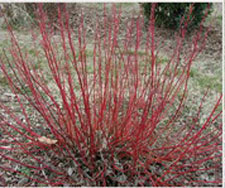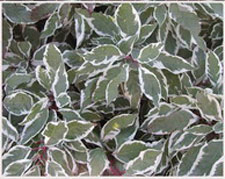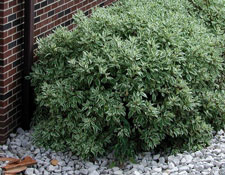Resource Library
Plant of the Week: Variegated Redstem Dogwood
The University of Arkansas System Division of Agriculture does not promote, support or recommend plants featured in "Plant of the Week." Please consult your local Extension office for plants suitable for your region.
Plant of the Week
[A-Z]
Variegated Redstem Dogwood
Latin: Cornus alba Elegantissima

Dogwoods are all-American trees, yet the tree we cherish for our springtime gardens is the exception, not the rule, amongst this group of plants.
Of the 45 species of dogwoods known to science, about five have the large showy bracts we associate with the trees blooming on our front lawn each spring. Most are a confusing group of brushy shrubs, some of which have made an impact on our gardens.
Of these the variegated redstem or Tatarian dogwood, Cornus alba ‘Elegantissima,’ is one of the most common in nurseries. It’s a shrubby plant growing to 5 feet tall and a bit wider with a compact habit. Its main ornamental feature is its compact form and a crop of attractive 3-inch long, white-margined variegated leaves. Of the variegated deciduous shrubs, this is arguably the most common and handsome of the lot.
If allowed to grow unpruned, the Tatarian dogwood will make 2-inch wide, flat-topped clusters of tiny yellowish-white blooms that appear after the plant has leafed out. The flowers on the shrubby dogwoods are not especially interesting. Clusters of white pea-sized berries are produced in mid to late summer but often go unnoticed before the birds get them.
In wintertime, the variegated Tatarian dogwood again makes its presence known in the garden. As winter arrives and frost kills the foliage, the young branches of this plant take on an iridescent reddish or coral colored glow. Bright red twigs sticking out of a snow bank or even punctuating a drab winter day make an attractive statement in the garden.

My use of "redstem" dogwood as the common name for this plant is inaccurate for there are two species to which this name can be applied. Cornus alba is more correctly called the Tatarian dogwood, an indication of its kinship with the geography and people of central Asia.
The invading forces under the command of Genghis Khan, about 1,200, were collectively called "Tatars" - i.e. the invaders. Originally, these people hailed from an area around Lake
Baikal in Siberia, but today the Republic of Tatarstan, carved from the old Soviet Union, lies north of Poland. This dogwood occupies a wide range of territory through much of Siberia, northern China and mountainous regions of Europe.
An American counterpart to the Tatarian dogwood and similar in most respects is the redosier dogwood, C. sericea (also sometimes listed as C. stolonifera). It occurs throughout much of the United States except for the southeaster states and shares the brightly colored

wintertime stems of its Old World relative.
The term "osier" is a reference to the slender branches of several willows used in weaving baskets. When the names redstem or redtwig dogwood is used, one is never quite sure which species is being referenced.
Both of these dogwoods are best in zones 3 through 7. In nature, they tend to grow along stream banks and low-lying, even boggy areas. Like the familiar flowering dogwood, they lurk at the edge of the woods where they get good light but not necessarily daylong sunshine.
In the garden, locate them in areas with a good, reasonably moist soil and some shade during the hottest part of the day, especially as you approach the southern end of the range where they will grow. The variegated Tatarian dogwood makes a good specimen in the shrub border, but if plants are grown primarily for their wintertime stem effect, they are best used in mass.
The stems lose their lustrous wintertime appearance as they age so it is important that plants be pruned on an ongoing basis. Some gardeners prefer to selectively remove one-third of the old stems every winter, but an easier approach is to cut the bushes back to 6-inch stubs every two or three years just before new growth begins in the spring.
By: Gerald Klingaman, retired
Extension Horticulturist - Ornamentals
Extension News - September 28, 2007
The University of Arkansas System Division of Agriculture does not maintain lists of retail outlets where these plants can be purchased. Please check your local nursery or other retail outlets to ask about the availability of these plants for your growing area.